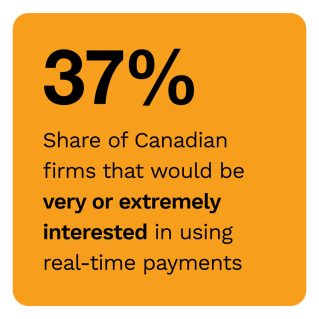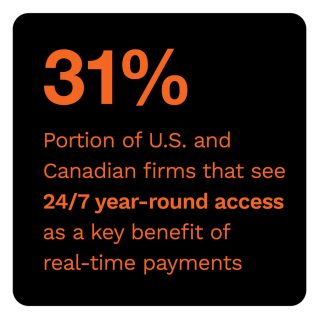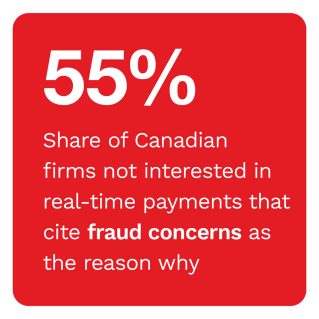NEW REPORT: Why Two-Thirds of US Businesses Resist Real-Time Payments Adoption

Real-time payments have become one of the key tools that United States businesses have at their disposal to keep their business-to-business (B2B) operations running smoothly. Not only do 22% of them report benefiting from the instant funds availability that real-time payments provide, but many also report benefiting from their 24/7 year-round access, enhanced transactional visibility, improved cash flow management and greater flexibility, among many other benefits.
Nevertheless, many U.S. firms choose not to use real-time payments, and many Canadian firms would not want to use them — even if they were available — chiefly because they hold misperceptions about the fraud risks involved or because firms may lack the infrastructure and in-house expertise needed to adopt them. These firms are left with a disadvantage against their competitors that use the operational benefits that real-time payments offer.
These are only a few key findings explored in the “Accelerating The Time To Realized Revenue: The Real-Time Payments Edition,” a PYMNTS and Mastercard collaboration. We surveyed 400 business leaders from across the U.S. and Canada about the digital payments innovations they have adopted, how many count real-time payments among those innovations, and the benefits that the technology has brought to their businesses.
 Key findings from our research include:
Key findings from our research include:
• Thirty-seven percent of all U.S. businesses are currently using real-time rails to pay or receive invoice payments, and 37% of all Canadian businesses want to use these payments. Year-round, 24/7 access to payments functionality is the chief benefit cited by 28% of U.S. firms that have adopted real-time payments.
• Large-market U.S. firms make and receive nearly twice as many real-time payments as midmarket U.S. firms. This could put midmarket firms at a competitive disadvantage, as many are not taking full advantage of real-time payments’ benefits, such as better cash flow management and 24/7 year-round access.
 • Concern about fraud is the foremost factor preventing businesses from adopting real-time payments, but this is not a concern among businesses that actually use these payments. Eighty-four percent of U.S. businesses that already use real-time payments say that fraud is not an issue they experience when using real-time payments.
• Concern about fraud is the foremost factor preventing businesses from adopting real-time payments, but this is not a concern among businesses that actually use these payments. Eighty-four percent of U.S. businesses that already use real-time payments say that fraud is not an issue they experience when using real-time payments.
These are only a few of the trends defining the usage of real-time payments across the U.S. and Canada. “Accelerating The Time To Realized Revenue: Real-Time Payments Edition” delves into the details of which businesses are using real-time payments and how it has impacted their broader payments operations.
To learn more about how U.S. and Canadian businesses use real-time payments to improve their payments operations, download the playbook.

